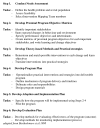Designing a workplace return-to-work program for occupational low back pain: an intervention mapping approach
- PMID: 19508728
- PMCID: PMC2700788
- DOI: 10.1186/1471-2474-10-65
Designing a workplace return-to-work program for occupational low back pain: an intervention mapping approach
Abstract
Background: Despite over 2 decades of research, the ability to prevent work-related low back pain (LBP) and disability remains elusive. Recent research suggests that interventions that are focused at the workplace and incorporate the principals of participatory ergonomics and return-to-work (RTW) coordination can improve RTW and reduce disability following a work-related back injury. Workplace interventions or programs to improve RTW are difficult to design and implement given the various individuals and environments involved, each with their own unique circumstances. Intervention mapping provides a framework for designing and implementing complex interventions or programs. The objective of this study is to design a best evidence RTW program for occupational LBP tailored to the Ontario setting using an intervention mapping approach.
Methods: We used a qualitative synthesis based on the intervention mapping methodology. Best evidence from systematic reviews, practice guidelines and key articles on the prognosis and management of LBP and improving RTW was combined with theoretical models for managing LBP and changing behaviour. This was then systematically operationalized into a RTW program using consensus among experts and stakeholders. The RTW Program was further refined following feedback from nine focus groups with various stakeholders.
Results: A detailed five step RTW program was developed. The key features of the program include; having trained personnel coordinate the RTW process, identifying and ranking barriers and solutions to RTW from the perspective of all important stakeholders, mediating practical solutions at the workplace and, empowering the injured worker in RTW decision-making.
Conclusion: Intervention mapping provided a useful framework to develop a comprehensive RTW program tailored to the Ontario setting.
References
-
- Waddell G. The Back Pain Revolution. 2. Edinburgh, Churchill Livington, United Kingdom; 2004.
-
- Waddell G, Aylward M, Sawney P. Back pain, incapacity for work and social secruity benefits: An international literature review and analysis. London, Royal Society of Medicine Press Ltd; 2002. Comparison of sickness and disability arrangements in various countries; pp. 73–100.
-
- Ontario Service Safety Alliance . Extending Your Reach: participating in health and safety research can produce more than you think, 2005 Annual Report. Missisauga, Canada, Ontario Service Safety Alliance; 2006.
-
- Workplace Safety & Insurance Board of Ontario . Statistical Supplement to the 2006 Annual Report of the WSIB, ed Annual Report Supplement 2006. Toronto, Canada, Workplace Safety & Insurance Board of Ontario; 2006.
Publication types
MeSH terms
LinkOut - more resources
Full Text Sources
Other Literature Sources
Medical
Miscellaneous


